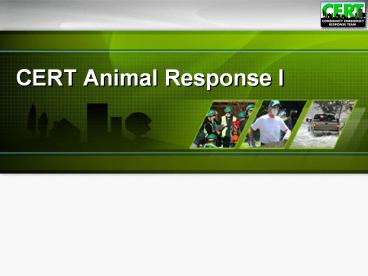CERT Animal Response I - PowerPoint PPT Presentation
Title:
CERT Animal Response I
Description:
CERT Animal Response I – PowerPoint PPT presentation
Number of Views:146
Avg rating:3.0/5.0
Title: CERT Animal Response I
1
CERT Animal Response I
2
Module Purpose
- The purpose of this module is to teach CERT
members emergency preparedness for animal owners
and how to recognize specific animal behaviors.
3
Animal Categories
- This module covers the following animal
categories - Household pets and domesticated animals
- Service animals
- For-profit animals
- Non-commercial livestock
- Wildlife
- Exotic animals
4
What You Will Learn
- Animal Issues in Emergency Management
- Animal-Related Emergency Management Functions
- Disaster Planning for Animals
- General Animal Behavior
- Preview of CERT Animal Response II
5
Module Objectives
- Explain why animal issues are an important
consideration in emergency management - Demonstrate knowledge of animal-related emergency
management functions - Explain emergency preparedness for animal owners
- Describe general guidelines for handling animals
6
Importance of Animal Issues
7
Animal-Related Emergency Functions
8
Disaster Planning for Your Animals
9
Preparing for a Disaster
- CERTs should prepare by
- Identifying potential hazards
- Mitigating the impact of hazards
- Creating a disaster plan
- Assembling disaster supplies
- Participating in training and exercises
- Knowing your communitys disaster response plan
10
Identifying Potential Hazards
- What types of disasters could occur in your
community? - Natural
- Technological
- Terrorist
- How could a disaster affect your animals?
11
Mitigating the Impact of Hazards
- Reducing the impact of disasters
- Making changes that protect properties or
facilities - Examples
- Encourage animal facilities to relocate out of
disaster-prone areas - Encourage animal facilities to have emergency
plans, including evacuation plans - Encourage livestock owners to develop plans to
remove animals when flooding is a threat
12
Creating a Disaster Plan for Animals
- Preparing to Evacuate Your Pet/Service Animal
- Preparing to Stay at Home With Pets/Service
Animals During a Disaster - Pet/Service Animal Care After a Disaster
- Preparations for Livestock
- Special Considerations for Exotic Animals
13
Preparing to Evacuate Your Pet/Service Animal
- Identify where you will stay if evacuated
- Plan your evacuation routes
- Update vaccinations and identification tags
- Gather evacuation supplies
- Make a plan for evacuating without your pet
14
Preparing to Stay at Home with Pets/Service
Animals
- Bring pets inside
- Have newspaper on hand
- Be aware that animals may isolate themselves if
afraid - Separate dogs and cats
- Separate smaller pets away from cats and dogs
15
Caring for Pets and Service Animals After a
Disaster
- Animal behavior may change after a disaster
- Leash pets for the first few days
- Displaced wildlife may pose a threat to pets
- Downed power lines are another hazard
16
Making Preparations for Livestock
- Ensure all animals have identification
- Have an evacuation plan
- Relocate on property
- Transport animals to safe site
- Evacuation sites should be prepared for livestock
- If not evacuating, identify safest shelter
- Take precautions in severe cold weather
17
Special Considerations for Exotic Animals
- Owners should have a plan to secure animals
during emergencies - Exotics may need to be separated from other
animals - Exotics may need to be registered with authorities
18
Assembling a Disaster Supply Kit
- Evacuation Checklist
- For pets/service animals
- For livestock
- Shelter-in-Place Checklist
- For pets/service animals
- For livestock
- Post information for emergency personnel on your
property
19
Grouping Animals
- What do these animals have in common?
20
Characteristics of Predator Animals
Feet
Teeth
Instincts
Vision
21
Grouping Animals
- What do these animals have in common?
22
Characteristics of Prey Animals
Vision
Feet
Teeth
Instincts
23
Animal Domestication
- Breeding species for desired characteristics
- Domesticated animal behavior
- Domesticated animals may revert to instinctive
behavior - Predator animals may chase and attack
- Prey animals may run or hide
24
Dog Facial Expressions
- Increasing Aggression
Increasing Fear
25
Dog Body Language
26
Dog Body Language (contd)
27
Dog Body Language (contd)
28
Dog Body Language (contd)
29
Dog Body Language (contd)
30
Dog Body Language (contd)
31
Cat Body Language
32
Cat Body Language (contd)
33
Horses, Cattle, and Swine
- Horses
- Instincts
- Senses
- Behavior
- Body language
- Cattle
- Bovines
- Bulls
- Tips
- Swine
34
Identifying Animal Behavior
35
Identifying Animal Behavior (contd)
36
Identifying Animal Behavior (contd)
37
Identifying Animal Behavior (contd)
38
Identifying Animal Behavior (contd)
39
Identifying Animal Behavior (contd)
40
Identifying Animal Behavior (contd)
41
Preview of Animal Response II
42
Preview of Animal Response II (contd)
- Come back for Animal Response II to learn
- Your role as a CERT member responding to animal
issues - How to protect yourself during animal encounters
- Knowledge and skills for CERT functions involving
animals
43
Module Summary
- In this module, we reviewed
- Animal Issues in Emergency Management
- Animal-Related Emergency Management Functions
- Preparedness for Your Animals
- General Animal Behavior































